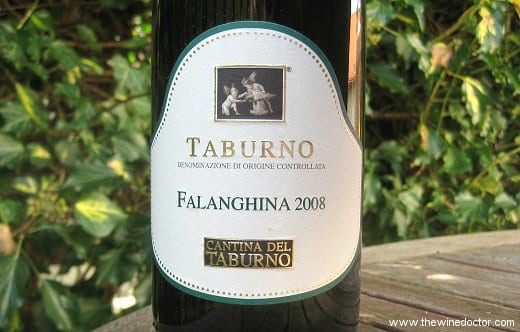Cantina del Taburno Falanghina 2008
I think it is essential to look somewhere other than Bordeaux today, as my continued reports from the 2009 Bordeaux primeur tastings will completely dominate this site for the rest of the week. Indeed, I’m moving not just out of Bordeaux but out of France, across the border into Italy. If we travel on down Italy’s west coast, past Rome and on to Naples, we reach Campania, the origin of this week’s wine, made from one of the region’s specialties, the Falanghina grape.
Italy as ever remains a hot-bed of interesting autochthonous varieties, with hundreds of different examples of Vitis vinifera under cultivation, transporting us far beyond the insular realms of Cabernet Sauvignon, Chardonnay and Merlot. Many are perhaps of ancient Greek origin, descendants of the original vines of the ancients, but all are certainly special in one way or another. Nevertheless, with so many different options it is inconceivable that they will all be cultivated and distributed to the point where they achieve international recognition. Some seem to have managed it; Fiano (produced in the region as Fiano de Avellino as well as in Sicily, where its resurgence seems to have began) has an increasing presence on the wine lists, and in red there is Aglianico too. Others, such as Asprinio, Biancolella and Sciascinoso seem destined to remain minority interests, for the moment at least.

Not so Falanghina. This almost-forgotten variety, rumoured to once have been the raw material for Falernian, the sweet white wine renowned in and around Rome two millennia ago, enjoyed a resurgence of interest and popularity (naturally encouraging a new wave of cultivation and availability) during the 1980s. The principal DOC for the variety here is Taburno, the vineyards of which are centred around the Monte Taburno near Benevento in the upper reaches of Campania. This is a region where vineyards mingle with olive groves, where small-scale production and polyculture is the norm. In such regions the co-operatives can play a vital role, bringing together these peasant farmers into a unified whole, providing equipment and services, improving quality through consultation, and of course marketing and selling the wines. With over 300 members the source of this wine, the Cantina del Taburno, is one such co-operative.
The wine in question is the 2008 Falanghina from the Cantina del Taburno, which is hand-harvested and fermented in stainless steel, before bottling two months later. Under DOC regulations the wine must be at least 85% Falanghina, so there may be up to 15% other varieties, such as Greco (as in Greco di Tufo, another well-known locally produced wine), Coda di Volpe and so on. It has an attractive green-tinged hue in the glass, and an open nose of honeydew melon and pear, cut through with a nice suggestion of minerals. Clean and well defined on entry, then showing a very flattering weight juxtaposed against a fine and zippy acidity, then broadening out in terms of flavour to reveal notes of pineapple, all the while maintaining a bright, fresh acid core. Fresh and lightly bitter in a delicious, savoury way. Overall, not only is this a fascinating wine, but it is also a very good one to drink! 16.5/20 (12/4/10)
